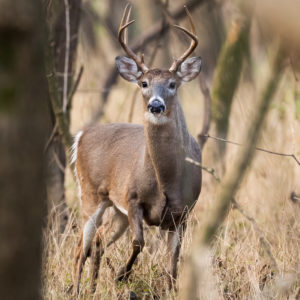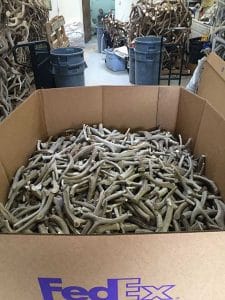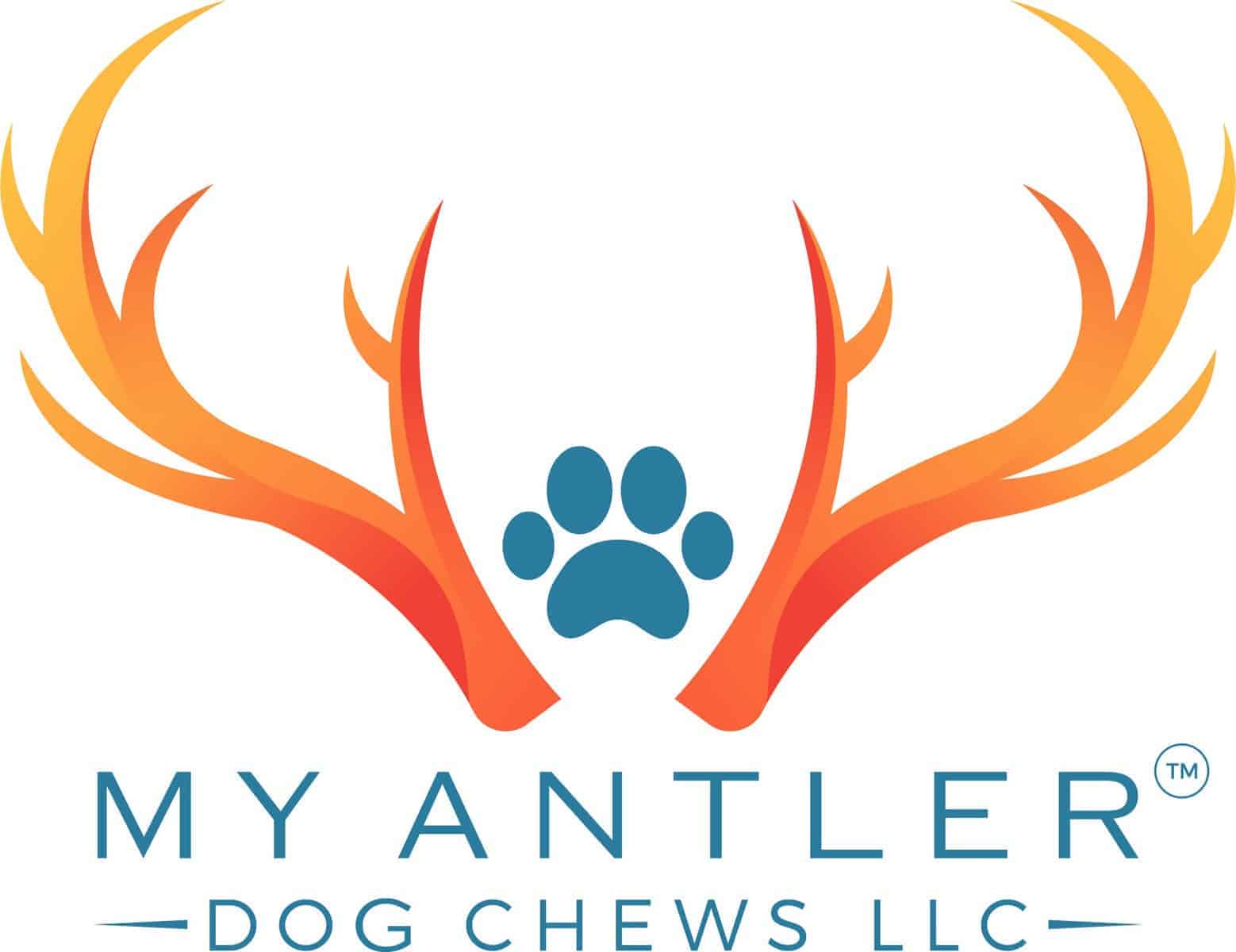My Antler Dog Chews sounds exactly like what it is. We sell antler chews for dogs. We named it that because every dog deserves the experience of being able to chew on an antler in their life time. In our case, many people have come back to give their dogs several chews over the course of their canine’s life. There are many benefits of antler chews for both you and your dog, and if you’ve never bought one before, this is a good place to start.
What is an antler, anyway?
What may surprise some people is that antler, whether an elk, deer, moose, etc., is bone. It is comprised of much of the same material as the bone that grows and supports the body inside. While antler may have different purposes than internal bones, antler has many similarities, as well. Inside the hard, protective shell is the marrow. Just like our own bones, antler bone marrow is the spongy tissue that carries oxygen throughout the body and can help fight infection. Within bone and marrow are many essential nutrients needed for bone to grow and for the body to use. Some of these nutrients are calcium, magnesium, iron, potassium, glucosamine and phosphorus. It’s these nutrients that dogs crave and taste when chewing on their antler dog chew. These nutrients are so rich and beneficial that shed antler are often sought after by smaller scavenging animals, such as rodents, beavers, squirrels, coyotes and even other deer.
A common question we often receive is “what is the difference between antlered animals and horned animals?” Antler and horn are very different but can easily be mistaken for one another. The biggest difference is that antler is shed, while horn stays connected to the host for life. Examples of horned animals are many different species of goat, sheep, buffalo, antelope, rhinoceros and other game of animals found in Africa, like kudu, impala, etc. Some antelope, such as the American Pronghorn, Antilocapra americana, are an exception. Unlike antler, horn is made of thick, matted hair, which is made of alpha-keratin, the same protein found in nails. In addition, horn can be found on females as well as males, whereas antler is mostly sex-specific (except reindeer and caribou). If you see a horn unattached from any one of these animals, this means the animal is most likely to be deceased. Antler, however, is a different story.

One major concern we’ve come across with our inventory is how we obtain it.
No, we do not kill any elk or deer for their antler. While hunting season is very popular in several areas in the United States for necessities such as food and income, there are other ways to access antler. Unlike horn, elk, deer, moose and other animals shed their antler annually. As with all nature, life follows a constant cycle. This is not an exception when it comes to bucks and their antler. When it sheds, the burr, which is the structure that connects the bone to the skull, will remain intact at the base of the antler. By looking at some of our antler on the website, you will see these burrs. Bulls/bucks usually shed their antler around late winter or early spring, thus becoming shed season. As another form of income or simply for collection, shed collectors will hike many miles to find these shed antler. These collectors may sell their found treasures to antler buyers, which is where we come in. Once we cut these nutritional treats, they are ready to be sold, either online or at the markets we attend, and we absolutely do not alter or modify them in any other way.
From velveting season in the spring to mating season in the fall, antler will have grown completely, making it the fastest-growing living tissue in nature. To highlight how important antler are and how they contribute to many things in life, we have outlined the timeline your dog’s healthy treat takes before it makes its way to your home.
Mid – Late Spring
In the first half of its cycle, antler is velvet to allow for blood flow and growth. In addition, it’s due to the longer days and low testosterone levels. Bulls/bucks will begin to show the first signs of tips that emerge from their skull. By the end of spring, the length from burr to tip will be about half of their final length.
Summer
By this time, antler will be at its peak of growth speed. By the end of summer, growing will be complete and the hardening process will begin.
Fall
Velvet will continue to peel as the antler hardens and bulls/bucks rub on trees. This rubbing is also what gives antler its rich, darker color. Once all blood flow stops, antler will be completely hardened into the tough, strong bone you know it to be. It also hardens due to shorter days and rising testosterone levels. During the high point of fall, males will use their rack in competing for mates and for protection.
Late Winter – Early Spring
Once late winter roles around, elk are in survival mode as they look for food to get through the winter. During this time, antler will start to fall off as they rub on bushes or trees to aid in their shedding process. Older bucks/bulls will usually shed their racks first, while younger ones will shed a little later in the spring.
Since this marrow is safely encased within the hard antler, we cut our chews in a way that will introduce your dog and want to eagerly work their way to the tempting inside. We cut our whole antler so there are at least two marrow sections exposed. For our half cuts, antler dog chews are cut long ways down the middle, exposing the entire middle for your dog’s desire. This entices your dog to the marrow inside, and they can begin to scrape, lick and chew these essential nutrients out of the antler.

Antler is great as a dog chew because of the toughness of its exterior. The newer the shed antler, the tougher it is and harder it is to break, crumble, or splinter. More recently shed antler that are found by shed collectors will avoid being exposed to the elements. Storing sheds indoors from the elements slows deterioration, allowing it to last many times longer. For example, an antler shed in the previous few years is so tough that grown adults have been able to stand on it without breaking. That’s why we only use antler from this recent season’s shed. New antler dog chews are so tough that it makes it very difficult for dogs to splinter or break it apart. In addition, the minerals and nutrients in antler and marrow are beneficial for dogs’ teeth and gums. They help whiten teeth and freshen breath in addition to the nutrients they will absorb.
If you are a pet owner who is debating on trying an antler for the first time, why not? It’s a great alternative to the “indestructible” toys that your ferocious baby is able to destroy and the non-digestible treats that are hard on their tummies. If you have any other questions or concerns, please feel free to visit our website at www.myantlerdogchews.com or contact us at jamie@myantlerdogchews.com.
References
Adams, K. (2015, April 10). Kip’s Korner: Antler Facts. Retrieved from https://www.qdma.com/kips-korner-antler-facts/
Kenyon, M. (2014, June 04). The Antler Growth Timeline. Retrieved from http://wiredtohunt.com/2010/05/03/the-antler-growth-timeline/
